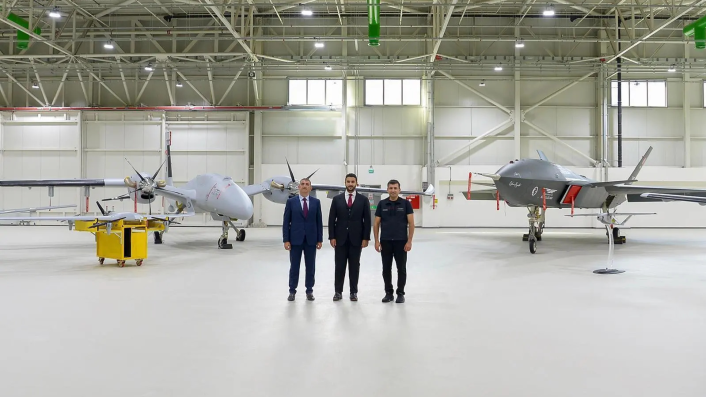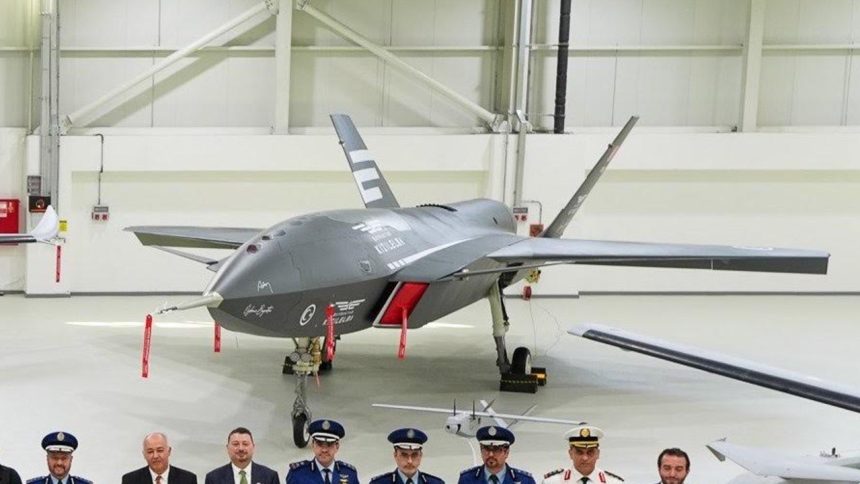The new design marks what appears to be a departure from the streamlined wing and body design that characterized the original prototype.
Turkey has unveiled a new prototype of the Kizilelma UCAV (Unmanned Combat Aerial Vehicle), the loyal wingman designed for the KAAN fifth generation stealth fighter, with significant structural and airframe differences than the one that has flown and displayed so far.
The UCAV was unveiled during the visit of a delegation from Saudi Arabia. According to the SPA (Saudi Press Agency), the delegation was led by Riyadh’s Minister of Defense Prince Khalid bin Salman bin Abdulaziz, who visited TAI (Turkish Aerospace Industries) and Baykar in Istanbul.
Ankara has been rapidly advancing its UCAV program, announcing a twin-engine supersonic version of the ANKA-3, and fielding the TCG Anadolu amphibious assault ship and drone carrier that will operate the Baykar TB3 and Kizilelma. Turkey is also testing its domestically developed TF10000 engines to power the KAAN, which currently flies with the US-made General Electric F110 turbofans.
Design differences in the new prototype
The Kizilelma UCAV flew for the first time in December 2022 and, during its second flight on Jan. 22, 2024, it “successfully passed the system identification test.” The latest Kizilelma prototype implies Baykar has rapidly incorporated changes and tweaks learnt while testing the first design. Let us take a look at what its new features and configurations are.
A split image shared by ‘Tr_tech’ on X featured both the prototypes for comparison. The difference that struck the eye was that in the original design, the top part of the engine air intake is flush with the fuselage, whereas in the new one the top part of the air intake slopes downwards. This also marks what appears to be a departure from the streamlined wing and body design that characterized the original prototype, with the air inlet and duct appearing almost like a separate body.
In Kizilelma new production prototype, Fuselage to which wings are attached has been significantly curved and engine exhaust is now much more prominent. There is a curved structure on the head I believe. The vertical stabilizers also seem to be more tilted from this angle https://t.co/mEFkX3NGQG pic.twitter.com/JwnTDA5uCX
— Tr_tech (@T_Nblty) July 3, 2024
In the new one, the top fuselage, engine and wing assembly sections appear to be sectioned and separate. A more pronounced bulge visible in the fuselage’s front section could possibly be meant to house the MURAD-200A AESA (Active Electronically Scanned Array) radar. Earlier reports said that the Aselsan-made MURAD was “integrated into the Akinci” and is also “critical for platforms such as the Kizilelma, KAAN, Hurjet and ANKA-3.”
Additionally, the spine extends into the rear section forming what appears to be a single tubular section housing the engine exhaust. In the earlier design, the wing and the tail joints merged along the same edge line. These are the most stark and distinct differences in the basic airframe design of the older and the new prototype.
The vertical stabilizers also appear to be larger and with a greater tilt angle, although this can’t be clearly verified. More photos from other angles and side views will throw more light on the new design configurations and the aerodynamics Baykar’s engineers might have in mind. What is not known, right now, is whether this prototype is meant for production or for the testing of a different configuration.

Design for supersonic flight
Turdef assess that that the new design changes “hint that this prototype might be designed to fly supersonic.” The publication notes significant differences on the control surfaces and most likely internal systems. “On the control surfaces, the flap arrangement is observed to be remade with two flaps instead of five on the wings,” says the report.
“The lower number of flaps might have been preferred to simplify the flight control. More importantly, the actuators for flaps and vertical stabilizers have been concealed, improving aerodynamics and reducing the RCS (Radar Cross Section),” added Turdef. “The fuselage’s backside is noticeably different from the first prototype, with a slant towards the rear end that will likely improve the aerodynamics.”
Interestingly, Turdef also notes that the “enlarged intakes hint at the arrival of an AI-322F after-burning turbofan engine,” which offers a maximum thrust of 44 kN at full afterburner. The prototype currently flies with the AI-25TLT engine, which has a maximum thrust of 16.9 kN.
The new prototype’s chin section is also missing the housing for TOYGUN-100 EOTS (Electro-Optical Targeting System), however it has a new housing on the top which might be for KARAT-100 IRST (InfraRed Search and Track).









